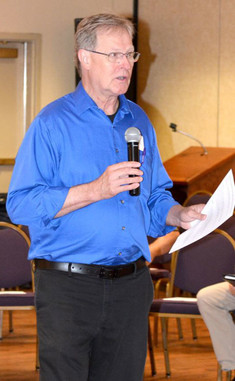Earn wellbeing program points

We're almost at the halfway mark to earn points for our wellbeing program to get $70 off your individual deductible in 2022 — this means it's a good time to check in on your progress.
You can earn points by completing healthy activities and if you earn 300 points by
Oct. 31, you'll get the deductible reward. All benefits-eligible state employees have access to this wellbeing program, which is run through Virgin Pulse. An overview video provides a helpful look into the Virgin Pulse platform and some of the features it offers.
Only employees enrolled in the Minnesota Advantage health plan are eligible for the reward. Learn more about eligibility, data security and data privacy in the FAQ.
Haven't started yet? No worries! There's still time. Check out new and upcoming activities that can help you reach your goals:
-
200 points: COVID-19 vaccine. Give your point level (and immune system) a boost by getting your COVID-19 vaccine(s). When you're done, collect your points by signing into your Virgin Pulse account and then clicking on the "home" icon the top navigation bar. Then select "how to earn" from the drop-down menu. Scroll down to the "participation" section and select "get your COVID-19 vaccine" to report.
-
25 points: Diabetes support. Use Omada to complete three program milestones in a week: weigh-in and glucose monitoring, meal tracking, and a lesson. You can complete this program up to six times, for a total of 150 points. Visit the SEGIP website to learn more and take a short questionnaire to find out if you meet the criteria for Omada. If you are eligible, you'll receive an email to enroll.
-
25 points: Attend wellbeing webinars. Our Employee Assistance Program provider offers new wellbeing webinars to help you focus on your health. Check out upcoming sessions and how to register.
Questions? Contact Laura Grunloh or Chrissy Eck if you have questions. For more information about DNR Wellbeing, visit our wellbeing page on the intranet. Employees may use lunch and break times to participate in wellbeing activities, and may seek supervisor approval for any additional time.
Support for your financial health
Our wellbeing program and Employee Assistance Program (EAP) provide resources to help you plan and manage your financial health.
Start a Virgin Pulse Financial Journey
Reaching a personal health goal starts with a single step. Our Virgin Pulse wellbeing platform provides a variety of “Journeys” through daily, self-guided courses to help you build healthy habits. From your Virgin Pulse account, navigate to “Health” and select “Journeys” to browse topic areas, including “Managing My Finances.”
You can select from topics including saving, shrinking debt, getting organized, maintaining financial fitness and planning for emergencies. Completing a Journey will earn you 50 points toward a $70 reduced deductible next year. Learn more about creating a Virgin Pulse account and how to earn the wellbeing reward on the State Employee Wellbeing Program website.
Get free support from a Coach
No matter what goal you’re trying to reach, a coach can help you stay motivated and accountable. Set up an appointment with a Virgin Pulse coach by calling 888-573-3113 or from your Virgin Pulse account, navigate to “Health” and select “Coaching,” then select the topic you’d like to focus on with a coach, such as “Be Financially Fit” or “Reduce Stress,” and schedule your first call. Before your session, think about what goals would be most meaningful to act on.
Engage with our Employee Assistance Program (EAP)
Get 24/7 access to expert, personal consultation on a wide range of concerns, from financial and legal matters to relationship challenges and family problems. Access our EAP work/life counselors anytime by calling 651-259-3840 or 1-800-657-3719 or text "Hello" to 61295. You can also visit the online resource library with password stmn1. Learn more on the EAP Work/Life Counseling website.
Juneteenth is now a federal holiday
Juneteenth (June 19) commemorates the end of slavery in the United States. Two-and-a-half years after President Abraham Lincoln's Emancipation Proclamation, on June 19, 1865, Union soldiers arrived in Galveston, Texas with news that the war had ended and that those who had been enslaved were now free.
Yesterday, Juneteenth became a federal holiday. In Minnesota , Gov. Walz and Lt. Gov. Flanagan have proclaimed June 19 as Juneteenth Freedom Day
There will be a number of Juneteenth events held in various locations around the state. You can learn more about this holiday at juneteenth.com.
See the links below for just some of the events you can attend in your community.
Hannah Mishler named CO of the Year
 (L-R) Col. Rodmen Smith, CO Hannah Mishler.
Hannah Mishler has been named the 2020 DNR Conservation Officer of the Year, an annual award given to an officer for outstanding overall career performance.
Mishler, who is stationed in Bemidji, has been a conservation officer since 2014. She and her K9 partner Storm are part of the Enforcement Division’s K9 Unit, and Mishler also routinely assists with teaching new conservation officers at Academies at Camp Ripley. She’s also an arson investigator and devotes time to helping other law enforcement personnel as part of the Enforcement Division’s peer support team.
“Our conservation officers do an amazing job of protecting Minnesota’s people and natural resources every day,” DNR Commissioner Sarah Strommen said. “We ask a lot of our officers, and they always answer the call. CO Mishler embodies what it means to be a conservation officer, and pushes a bar that’s already been set high even higher.”
Col. Rodmen Smith, director of the DNR Enforcement Division, added: “In her time with the DNR, CO Mishler has proven herself to be an exceptional officer who’s always willing to help her partners and do what it takes to get the job done. She’s highly visible in her community – whether she’s in the woods, on the water or sharing her passion for the outdoors at public events – and positively reflects the values and mission of the Enforcement Division and the department as a whole.”
Other Enforcement Division honorees are listed in this news release.
DNR sweeps MAGC awards
DNR communications staff are seeing gold after sweeping last week’s Northern Lights Awards.

The DNR received seven awards during the ceremony, which is hosted by the Minnesota Association of Government Communicators to honor the best communications work by government entities in Minnesota.
The DNR won four Northern Lights Awards, which are given to one entry in each category whose quality “wows” the judges—exceeding expectations, accomplishing intended goals, demonstrating creativity and making excellent use of available resources.
Staff also won two Silver Awards, which are granted to superbly executed entries that accomplish their goals with creativity and outstanding design.
Most impressive of all: Minnesota Conservation Volunteer magazine took “Best of Show” with its story In Search of Cabbage Rocks, featured in the September-October 2020 issue. The Best of Show award is chosen from amongst all of the Northern Lights Award winners as the very best example of government communications.
To view all of the winning entries, log onto the MAGC 2021 Awards Gallery.
Congratulations to all of our DNR winners!
Silver Awards
- CSU - Deb Rose – Old Growth: Interstate State Park (Photography)
- DNR – The Great Minnesota Outdoor Adventure/Virtual State Fair (Virtual Events)
Gold Awards
- CSU - Amy Beyer – Factors of Success Infographic (One-page publication)
- MCV - Champion Cyclist: Alexandera Houchin (Photography)
- MCV – In Search of Cabbage Rocks article (Writing)
- PAT - Trailblazer (Newsletter)
Best of Show
- MCV – In Search of Cabbage Rocks article
|
Recruitment and career engagement resources
Over the past several months, the DNR has created new recruitment and career engagement resources for staff and has deepened relationships designed to help us recruit a workforce that reflects the diversity of the state.
MANRRS Conference
In April, the DNR, MN Department of Agriculture and Board of Water and Soil Resources served as national hosts for the virtual Minorities in Agricultural, Natural Resources and Related Sciences conference.
As a host, the DNR was active in the planning process and employees Bob Milne, Kenny Blumenfeld and Rowzat Shipchandler presented at/moderated sessions on natural resource topics. The agency also participated in a virtual career fair, with Greg Snyder and Nicole Tefft staffing.
Several DNR employees also attended the conference as participants. Ecological and Water Resources planner April Rust said:
“As a first-time attendee, I was eager to learn and listen for ways in which I could better support increased diversity, equity and inclusion in the natural resources field. The most impressive takeaway for me as a planner was the clear overriding focus on supporting attending students to help prepare them for many facets of successful agricultural and natural resource-focused careers. I was not the target audience for much of the messaging, but the lessons shared resonated and challenged me to see myself as part of this supportive community.
Since the conference, I have found myself considering what ways we here at DNR can better connect with students of color and how we can prepare a more inclusive and welcoming culture here.”
Partnership with Bridges Career Academies
The DNR partnered with Bridges Career Academies in the Brainerd area to create a video on natural resources careers. The video is part of a series that showcases career paths for high school students. Ann Danielson, Theresa Ebbenga and Devon Wenthe star in this video.
Web site enhancements
In December 2020, the DNR launched a new career web site with more robust information about jobs at the DNR. Over the spring, we published a series of pages on natural resource career paths within the DNR.
This section is designed for high school and college students. These enhancements were part of the Find it in Nature project, which includes Elyse Anderson, Betsy Cotone, Maggie Snyder and Rowzat Shipchandler as project team members or implementers and Denise Legato, Jenna Covey and Randolph Briley as sponsors.
Resources for staff
- Resources are available on the intranet for those staffing career fairs or career engagement events. These guides will help you talk about DNR careers in general to external audiences.
- Staff who are recruiting or participating in career engagement activities are invited to be part of a Teams group to coordinate and share resources. To join, open Teams, Go to create/join team and type in this Team Code:
For more information or if you have any questions on these, reach out to Rowzat Shipchandler.
Omada expands to help manage and prevent diabetes

Diabetes is one of the fastest growing diseases in the U.S. We understand the challenges you might experience if you have or are at risk for diabetes. That’s why we offer the Omada program as a part of your benefits, which now includes new diabetes management tools.
Omada is a personalized program that can help you reach your health goals, whether its losing weight, managing your diabetes, or improving your overall health. It’s available at no cost to you and adult dependents enrolled in the Minnesota Advantage Health Plan.
It features:
- A personalized health program based on your goals
- A health coach to keep you on track
- Devices, such as a smart scale and/or glucose meter
- An online community tailored to your interests
Get started! Learn more about Omada. You can take a short questionnaire to find out if you or one of your dependents are eligible. Individuals who did not previously qualify may now be eligible with the expanded benefits.
Did you know… If you or your family members has diabetes, you also automatically receive the Advantage Value for Diabetes benefit. This can help lower your out-of-pocket costs for high-value services, prescriptions, and testing supplies. Learn more.
Update: Interdisciplinary forest management policy system
An interdisciplinary team from the divisions of Forestry, Fish and Wildlife, and Ecological and Water Resources recently completed revisions to the Interdisciplinary Forest Management Policy System (Policy System), one of three operational policy systems at the DNR.
This Policy System applies to forest management activities on DNR lands administered by the divisions of Forestry and Fish and Wildlife, as outlined in the Interdisciplinary Forest Management Coordination Framework.
This project successfully implemented an interdisciplinary approach to update and add clarity to the system so that its policies and guidelines can be more easily organized, vetted, implemented, and communicated across divisions.
Revisions include:
-
Updated policy system intranet site
-
Updated list of directional documents (policies, guidelines, etc.)
-
New cover sheets for policies and guidelines
-
New procedures and templates that will provide structure and guidance for interacting with the Policy System
Please reach out to Lacy Levine, the forest policy program consultant (and Interdisciplinary forest management policy system administrator), with any questions.

Champion collaborator Brian Stenquist reflects on DNR career
EWR planner has worked for agency since 1981
By Greg Husak, information officer, Ecological and Water Resources Division
The first thing Brian Stenquist says about a career at the DNR spanning five decades is that he has felt “honored to be part of an organization that has been on a trajectory of change and improvement.”
Brian is taking a look back and a look ahead as he prepares to retire at the end of this month.

“When I entered the agency in ’81, we were really a confederation of distinct disciplines that were just loosely connected to one another. We have traveled a journey of slowly integrating across those intellectual and political silos and boundaries to aspiring now to be One DNR.”
A major part of Brian’s work has been to bring people together has been his long-standing commitment to diversity, equity and inclusion.
“When I first started as a student worker, the edge was ‘affirmative action.’ I don't think Joe Alexander (DNR Commissioner from 1978 to 1990) gets enough credit for his commitment to diversity, equity and inclusion, along with (former Affirmative Action Director) Perry Pickens.
To some extent, the DNR can be seen as a microcosm of the quality of conversations at national level. I think the next burst was Commissioner Rod Sando (1991-1998) really trying to improve our understanding of white privilege. I think it actually emerged out of Macalester College, a professor there coined the term and we started using it inside the agency to try to recognize that whiteness gave people opportunities that other folks didn't have.
So, it has become a progression from quotas to privilege to personal responsibility to take action, which is great, it's the right progression. It's disheartening that it takes so long, but it is heartening that it continues to move forward. But we also have to deal with the challenge of a country built on genocide of indigenous populations.
Obviously, Lt. Gov. Flanagan is a strong voice, and I think Gov. Walz and Commissioner Strommen are emphasizing that this long road slowly arcs toward justice. And we get a chance to walk it, which is a real privilege and honor in the DNR, so I encourage our colleagues to not be afraid of it but to embrace it.”
|
Brian’s role as a planner has consistently focused on improving collaboration. He was an early champion of meeting facilitation.
“In the mid-1970s, there was a growing recognition that, in bringing people together in problem-solving settings, somebody beside the chairperson needed to run the meeting.”
He recommends “How To Make Meetings Work” by David Straus and Michael Doyle. On the communications side of the equation, he noted “this upwelling desire to be better communicators, but proliferation of an un-curated information sphere is a deep challenge to a culture going through Future Shock. So, how do we make our communications simpler and better?”
Brian has also worked to foster what he calls good followership.
“We're an organization that has very strongly advocated developing leadership, which is really good. But there’s an old adage that if you're aspiring to be a leader and you turn around and there's nobody following you, you're just a person out for a walk. People don't aspire to being a great follower but, in my own experiences, that's been the hardest work. How do I follow well? How do I challenge and offer and then support the leaders around me?”
Brian’s love of books, especially poetry, is well-known. As possibly the only participant in every annual DNR Roundtable, he usually started the Roundtable with a poem he wrote.
When asked what poem he would recommend for fellow DNR employees, Brian thought of Gary Snyder’s “For the Children,” which concludes with this guidance: stay together, learn the flowers, go light.
 Name: Brian Stenquist
Title: Communications and Planning Unit supervisor, Ecological and Water Resources Division
Joined the DNR: December 1981
Work location (after telework ends): Central Office
Education: Bachelors degree in Cultural Anthropology, University of Minnesota. Studied Planning and Public Affairs at the Humphrey Institute, and Soil Science at the University of Minnesota--teaching assistant for the introductory Soil Science Laboratory.
Fun fact: Brian cites Yoga and meditation as key life practices.

Forestville/Mystery Cave State Park
 Hackberry emperor butterflies land on Dawn Ryan, cave supervisor, Mystery Cave State Park. Photo by Deb Rose.
Forestville/Mystery Cave State Park was swarming with butterflies this week after a recent hatch of the hackberry emperor butterfly. Hackberry butterflies are found in the vicinity of hackberry trees and bushes where, as larvae, they feed in colonies.
The caterpillar feeds on hackberry shrubs solely and hibernates when partly grown.
The female hackberry butterfly remains near it’s tree while the males wander a little distance. They eat dung, carrion, sap, and will even converge on hummingbird feeders competing with the birds.
Once a butterfly, they live very short lives – about two weeks usually. They are important because they are a food source for birds, because the world is better off with more plant and animal diversity, and we could use more beauty in this world, especially now.
- Dawn Ryan
|